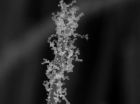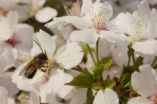(Press-News.org) Scientists at the University of Liverpool have found that mice and rats have evolved to gnaw with their front teeth and chew with their back teeth more successfully than rodents that 'specialise' in one or other of these biting mechanisms.
Researchers designed a computer model to simulate the bite of rats to understand whether their skull shape or muscle arrangement was a major factor in their evolutionary success and global dominance, making them one of the most common pest species in the world.
Research has already shown that rats and mice can both chew and gnaw, whereas other rodents, such as squirrels, specialise in gnawing, and some, like guinea pigs, specialise in chewing. To understand whether the rat's ability to do both made its bite more effective, the Liverpool team took the anatomical features of rats, squirrels and guinea pigs and fed them into a computer model to simulate the different biting mechanisms.
They also created virtual animals with a rat skull and squirrel muscles, for example, to investigate whether it was adaptations of the skull or jaw muscles that gave rats their biting abilities. The findings, published in the journal PLoS ONE, showed that it is the rat's muscles that increase bite efficiency, allowing it to gnaw and chew with more success than species that specialise in just one of these methods.
Dr Nathan Jeffery, from the University's Institute of Ageing and Chronic Disease, said: "Mice and rats belong to a group of rodents called the myomorphs, which are amongst the most successful of all mammals. With over 1000 species, comprising nearly a quarter of all known mammal species, they live in a wide variety of habitats on every continent, except Antarctica."
Dr Philip Cox, co-author of the research, added: "Since the Eocene era, approximately 56 to 34 million years ago, rodents have been adapting their skulls and jaw muscles in, what we might call an evolutionary race. A group of rodents called sciuromorphs, which includes the squirrel, began to specialise in gnawing adaptations, and the hystricomorphs, including the guinea pig, chose chewing. The myomorphs, the rats and the mice, however, adapted to both chewing and gnawing.
"We wanted to understand the evolutionary success of mice and rats and hypothesised that their generalised feeding behaviour played a significant role. Through using reverse engineering techniques we were able to recreate the bite of the rat, as well as test whether its success was attributed to the arrangement of their skull or jaw muscles."
Dr Jeffery said: "We expected that the rats we created in the computer model would be more versatile, but less effective, than the specialist squirrel and guinea pig – you would not expect a triathlon swimmer to beat, for example, a dedicated 1500m swimmer.
"The results, however, showed that the way rat muscles have adapted over time, has increased their ability to chew more effectively than a guinea pig and gnaw better than a squirrel, even though these two species are specialists in these kinds of jaw movements. This goes some way to explaining why rats and mice are so successful, as well as destructive, as their versatile feeding behaviour allows them to eat through a wide variety of materials efficiently."
###The study was funded by the Natural Environment Research Council (NERC) and involved researchers at the Universities of Hull and Bristol, as well as collaborators from the Muséum National d'Histoire Naturelle, Paris and Shinshu University, Japan.
Notes to editors:
1. Dr Philip Cox conducted the research, with Dr Nathan Jeffery, whilst working at the University of Liverpool. He is now working at the University of Hull.
2. The University of Liverpool is one of the UK's leading research institutions with an annual turnover of £410 million, including £150 million for research. Liverpool is ranked in the top 1% of universities worldwide and is a member of the Russell Group.
Research shows rats have best bite of rodent world
2012-04-30
ELSE PRESS RELEASES FROM THIS DATE:
New form of intellectual disability discovered
2012-04-30
(Toronto) - Researchers at the Centre for Addiction and Mental Health (CAMH) led a study discovering a gene for a new form of intellectual disability, as well as how it likely affects cognitive development by disrupting neuron functioning.
CAMH Senior Scientist Dr. John Vincent and his team found a mutation in the gene NSUN2 among three sisters with intellectual disability, a finding to be published in the May issue of the American Journal of Human Genetics.
The discovery was made after mapping genes in a Pakistani family, in which three of seven siblings had intellectual ...
Bejeweled: Nanotech gets boost from nanowire decorations
2012-04-30
Like a lead actress on the red carpet, nanowires—those superstars of nanotechnology—can be enhanced by a little jewelry, too. Not the diamonds and pearls variety, but the sort formed of sinuous chains of metal oxide or noble metal nanoparticles.
Though science has known for some time that such ornamentation can greatly increase the surface area and alter the surface chemistry of nanowires, engineers at Stanford University have found a novel and more effective method of "decorating" nanowires that is simpler and faster than previous techniques. The results of their study ...
When to have kids: A complex question for hazel dormice
2012-04-30
Claudia Bieber from the Research Institute of Wildlife Ecology (FIWI) of the University of Veterinary Medicine, Vienna, and fellow scientists analysed a capture-recapture data set on common dormice (Muscardinus avellanarius) to investigate the life-history strategy of this species. These small rodents are about the size and weight of a wood mouse (Apodemus sylvaticus), but, unlike their rodent cousins, they hibernate – usually from late September/October to April/May. This is reflected in rather different life history strategies: While wood mice may reproduce any time between ...
Polluting China for the sake of economic growth
2012-04-30
China's economic growth will continue to be energy-intensive and highly polluting for the foreseeable future with emissions and efficiency far below capital growth on the agenda, according to a study published in the International Journal of Global Energy Issues.
Economist Yanqing Xia of Dongbei University of Finance and Economics and the Northeast Branch of the Chinese Academy of Sciences in Liaoning has looked at almost a decade's worth of data from 30 Chinese provinces to build a comprehensive model of pollution, energy consumption and economic growth. The model offers ...
Doubling the information from the double helix
2012-04-30
Our genes control many aspects of who we are — from the colour of our hair to our vulnerability to certain diseases — but how are the genes, and consequently the proteins they make themselves controlled?
Researchers have discovered a new group of molecules which control some of the fundamental processes behind memory function and may hold the key to developing new therapies for treating neurodegenerative diseases.
The research, led by academics from the University of Bristol's Schools of Clinical Sciences, Biochemistry and Physiology and Pharmacology and published ...
Deadly decision: Obese drivers are far less likely to buckle up
2012-04-30
BUFFALO, N.Y. -- Obese drivers are far less likely to wear seatbelts than are drivers of normal weight, a new University at Buffalo study has found, a behavior that puts them at greater risk of severe injury or death during motor vehicle crashes.
The UB study found that normal weight drivers are 67 percent more likely to wear a seatbelt than morbidly obese drivers. Drivers were considered overweight or obese if they had a BMI (body mass index) of 25 or more, according to the World Health Organization definition of obesity, with 25-30 defined as overweight, 30-35 slightly ...
Fruit flies provide new knowledge about uninhibited cell growth
2012-04-30
In a new study, scientists at the University of Copenhagen show that a specific type of carbohydrate plays an important role in the intercellular signalling that controls the growth and development of the nervous system. In particular, defects in that carbohydrate may result in the uninhibited cell growth that characterizes the genetic disease neurofibromatosis and certain types of cancer. The results have just been published in the well-reputed journal PNAS.
Scientists from The Faculty of Health and Medical Sciences at the University of Copenhagen have put a special ...
Researchers from the University of Zurich discover new particle at CERN
2012-04-30
This press release is available in German.
In particle physics, the baryon family refers to particles that are made up of three quarks. Quarks form a group of six particles that differ in their masses and charges. The two lightest quarks, the so-called "up" and "down" quarks, form the two atomic components, protons and neutrons. All baryons that are composed of the three lightest quarks ("up", "down" and "strange" quarks) are known. Only very few baryons with heavy quarks have been observed to date. They can only be generated artificially in particle accelerators as ...
Atomic clock comparison via data highways
2012-04-30
This press release is available in German.
Optical atomic clocks measure time with unprecedented accuracy. However, it is the ability to compare clocks with one another that makes them applicable for high-precision tests in fundamental theory, from cosmology all the way to quantum physics. A clock comparison, i.e. a comparison of their optical frequencies, proved to be challenging so far as the few existing optical clocks around the world are not readily portable due to their complex nature. A team of researchers from the Physikalisch-TechnischeBundesanstalt (PTB) in ...
Global prices of pollination-dependent products such as coffee could rise in the long term
2012-04-30
This press release is available in German.
Leipzig/Dresden/Freiburg. In recent years the economic value of pollination-dependent crops has substantially increased around the world. As a team of researchers from the Helmholtz Centre for Environmental Research (UFZ), the Technical University of Dresden and the University of Freiburg headed by the UFZ wrote in an article entitled "Spatial and temporal trends of global pollination benefit" in the open-access journal PLoS ONE the value of ecological pollination services was around 200 billion US dollars in 1993 and rose ...


